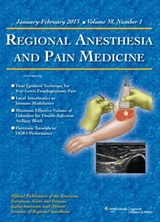
Arthroplasty
Intermittent superior to continuous lumbar plexus block for pain reduction and opioid use in THA
Reg Anesth Pain Med. 2019 Jun;44(6):632-636.40 patients scheduled for total hip arthroplasty were randomized to post-operative analgesia with either an intermittent or continuous lumbar plexus block (LPB). The primary outcome of interest was cumulative fentanyl consumption. Secondary outcomes of interest included pain at rest and during movement (measured on a Visual Analog Scale (VAS)), the number of demands for and successfully delivered rescue analgesia, and the number of segments with sensory blockade. Follow up was performed up to 48 hours post-operation. Results revealed significantly lower fentanyl consumption in the intermittent group compared to the continuous group up to 48 hours post-operation. VAS pain scores at rest and during motion were largely in favour of the intermittent group. The number of demands for an successfully delivered rescue analgesics were significantly lower in the intermittent group compared to the continuous group. Sensory blockade declined significantly from 2 hours post-operation in the continuous group.
Unlock the full article
Get unlimited access to OrthoEvidence with a free trial
Start TrialCritical appraisals of the latest, high-impact randomized controlled trials and systematic reviews in orthopaedics
Access to OrthoEvidence podcast content, including collaborations with the Journal of Bone and Joint Surgery, interviews with internationally recognized surgeons, and roundtable discussions on orthopaedic news and topics
Subscription to The Pulse, a twice-weekly evidence-based newsletter designed to help you make better clinical decisions
Exclusive access to original content articles, including in-house systematic reviews, and articles on health research methods and hot orthopaedic topics
Or continue reading this full article
Register Now

Subscribe to "The Pulse"
Evidence-Based Orthopaedics direct to your inbox.




































